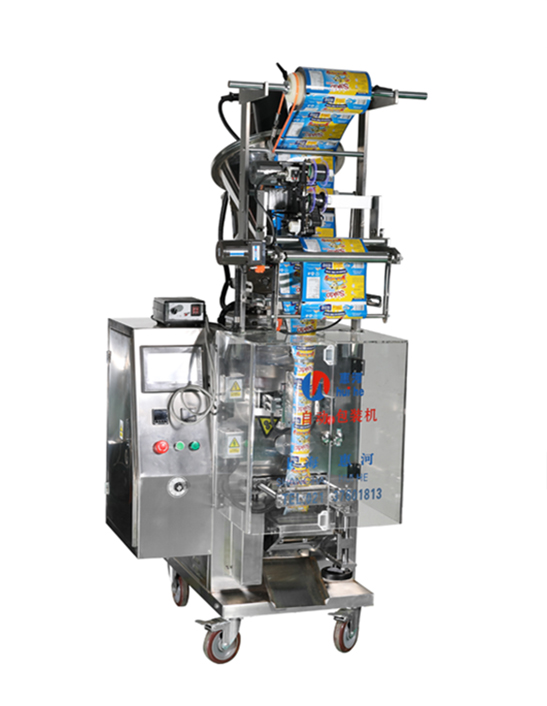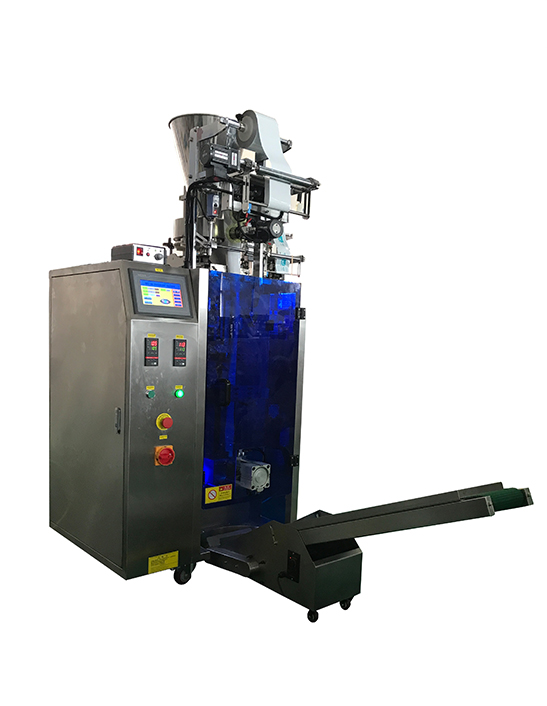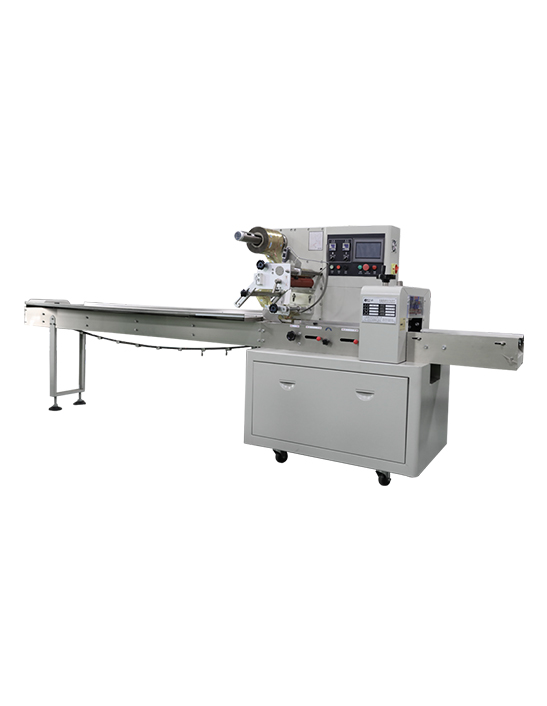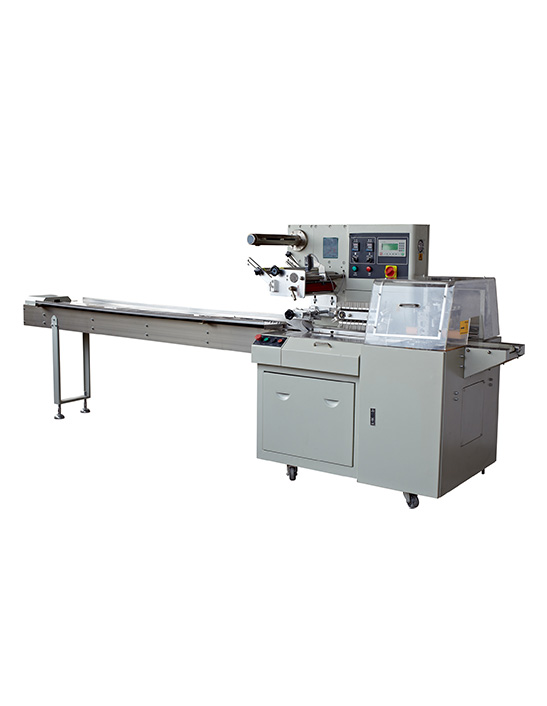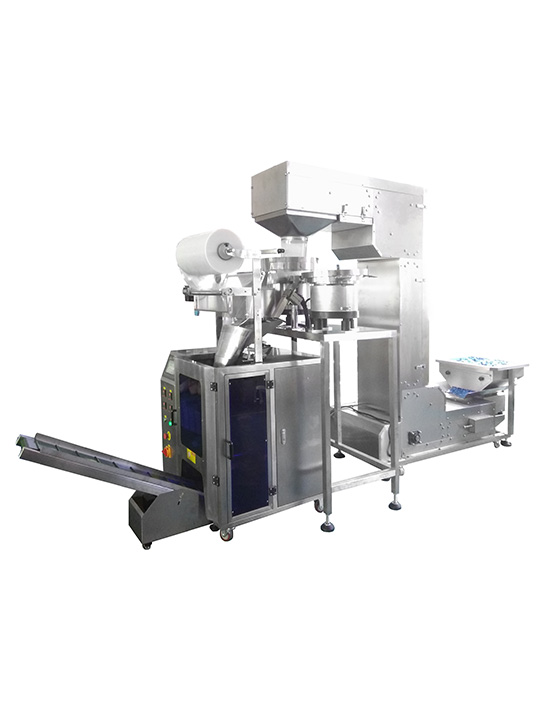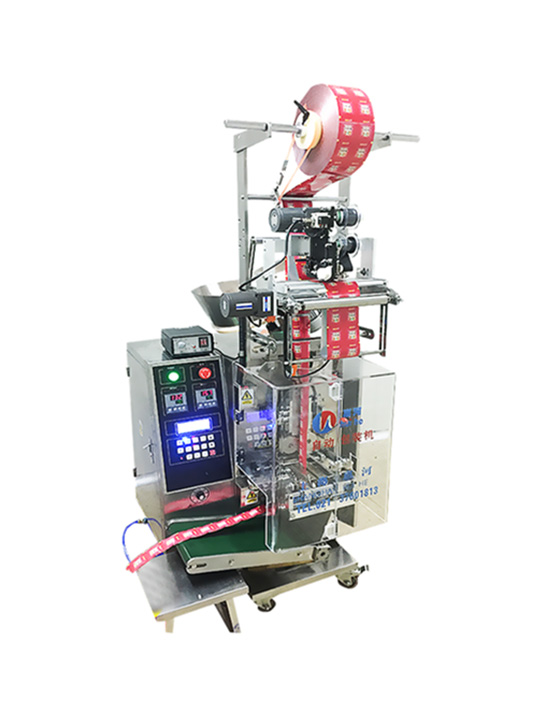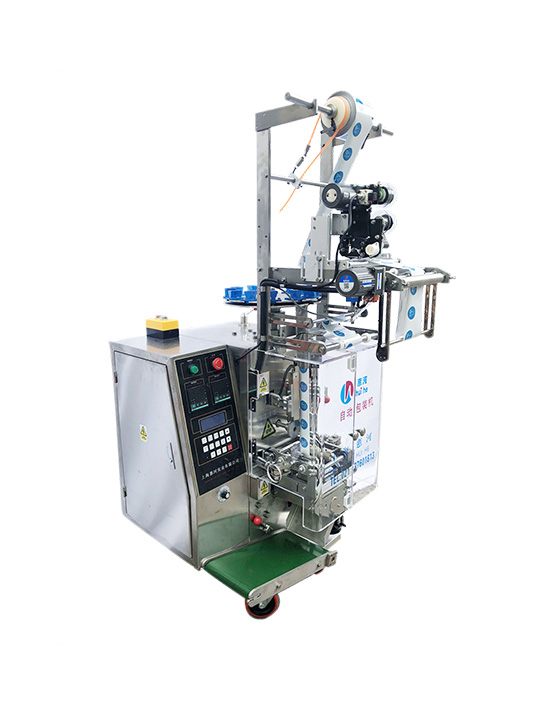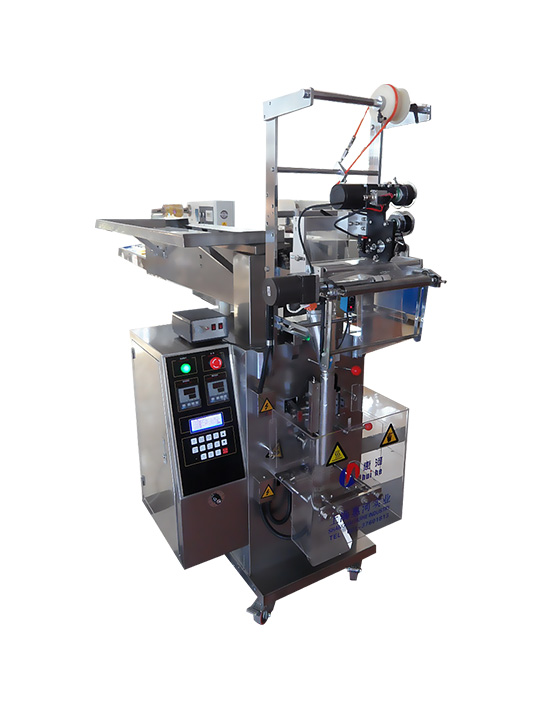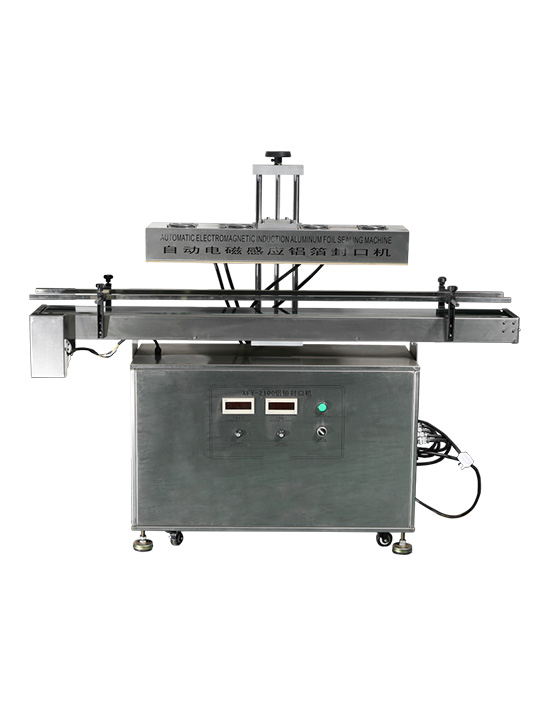1. Introduction to Horizontal Packing Machines
In the fast-paced world of manufacturing and consumer goods, packaging is far more than just a protective layer; it's a critical element for product presentation, preservation, and market appeal. As industries strive for greater speed, consistency, and cost-effectiveness, the role of advanced packaging machinery becomes paramount. Among these innovations, the horizontal packing machine stands out as a cornerstone of modern packaging efficiency.
1.1 What is a Horizontal Packing Machine (HFFS)?
A Horizontal Packing Machine, often referred to as a Horizontal Form-Fill-Seal (HFFS) machine or a Flow Wrapper, is a type of automated packaging equipment designed to continuously create flexible packages (pouches or bags) from a roll of film, fill them with a product, and then seal them horizontally. The "horizontal" aspect refers to the direction in which the product travels through the machine, moving along a conveyor belt, or being manually placed into the film web. The machine forms a continuous tube around the product, seals it longitudinally (fin seal), and then cuts and seals the ends to create individual packages. This method is highly versatile, accommodating a vast array of solid, semi-solid, and even some liquid products.
1.2 Brief History and Evolution
The concept of automated packaging began to take shape in the early 20th century, with significant advancements occurring after World War II. Early machines were relatively simplistic, but the demand for higher production speeds and more efficient processes spurred innovation. The development of plastic films in the mid-20th century was a game-changer, enabling the continuous flow wrapping process that defines horizontal packing today. Over decades, these machines have evolved from purely mechanical systems to highly sophisticated, computer-controlled (PLC and HMI-driven) units, incorporating servo technology for precision and flexibility, and integrating seamlessly into complete packaging lines.
1.3 Importance in Modern Packaging Industry
Horizontal packing machines are more critical than ever in today's packaging landscape due to several factors:
Mass Production Efficiency: They enable high-speed packaging, allowing companies to meet the demands of large-scale production and rapid market changes.
Cost Reduction: By automating the packaging process, they significantly reduce labor costs and minimize material waste.
Product Protection and Shelf Life: The hermetic seals and controlled atmosphere (if applicable) provided by HFFS machines extend product freshness and protect against contamination, crucial for food and pharmaceutical products.
Versatility: Their adaptability to various product types, sizes, and film materials makes them a go-to solution across diverse industries.
Branding and Presentation: HFFS machines produce aesthetically pleasing packages with consistent seals, enhancing product presentation and brand image on retail shelves.
In essence, horizontal packing machines are not just equipment; they are vital strategic assets that enable businesses to deliver products efficiently, safely, and attractively to consumers worldwide.

2. Types of Horizontal Packing Machines
While the term "Horizontal Form-Fill-Seal (HFFS)" is often used broadly to describe this category, there are distinct types and variations based on their working principles and the specific characteristics of the packages they produce. Understanding these differences is key to selecting the right machine for a given product.
2.1 Flow Wrapping Machines
Flow wrapping machines are perhaps the most common type of horizontal packing machine, known for creating a "pillow-pack" style bag. They are essentially a continuous motion HFFS process.
2.1.1 Working Principle:
Film Unwinding: A roll of flexible packaging film is unwound and fed into the machine.
Tube Forming: The film passes over a forming box (or former), which shapes it into a continuous tube around the product. The product is fed horizontally, either manually or via an automated infeed system, directly into this tube.
Longitudinal Sealing (Fin Seal): A sealing mechanism (usually heated rollers or wheels) creates a continuous seal along the length of the film, typically on the underside of the package, forming a "fin" (hence "fin seal" is closely related to flow wrapping).
Transverse Sealing and Cutting: Once the product is inside the film tube, a set of heated jaws descends vertically to create the top and bottom seals of adjacent packages simultaneously. At the same time, a knife cuts the individual package from the continuous film web.
Discharge: The finished, sealed package is then discharged from the machine.
2.1.2 Applications: Flow wrappers are incredibly versatile and widely used for:
Bakery Products: Cookies, crackers, bread rolls, cakes.
Confectionery: Candy bars, chocolates, lollipops, snack cakes.
Snack Foods: Energy bars, small bags of chips (though vertical FFS is more common for loose chips).
Non-Food Items: Hardware (screws, small parts), soap bars, single-use medical devices, cosmetics (single-serve wipes, small bottles).
2.2 Fin Seal Machines
The term "Fin Seal Machine" often refers specifically to the longitudinal sealing method characteristic of flow wrappers. While not a distinct machine type in the same way as "flow wrapper," it highlights a critical sealing mechanism.
2.2.1 Working Principle: In a fin seal process, two layers of film are brought together and sealed along their edges to form a "fin." This fin is then folded flat against the package body. This is distinct from a lap seal, where one edge of the film overlaps the other and is sealed to it. Fin seals are strong and reliable, as they involve sealing two inner (often heat-sealable) layers together.
2.2.2 Applications: As discussed, fin sealing is integral to virtually all flow wrapping applications due to its robust sealing capabilities and suitability for a wide range of film materials. Any product packaged by a flow wrapper will typically have a fin seal.
2.3 Form-Fill-Seal (FFS) Machines
While HFFS generally refers to horizontal machines, "Form-Fill-Seal" is a broader category. When used specifically, it often highlights machines that form the entire pouch from flat film (often two rolls) before filling, rather than just wrapping around an existing product. However, in the context of horizontal, it's often synonymous with flow wrappers. It's important to distinguish from Vertical Form-Fill-Seal (VFFS) machines, which create stand-up pouches or bags for free-flowing products.
2.3.1 Working Principle (in the horizontal context): In a horizontal FFS machine, flat film (or sometimes two webs) is drawn through the machine. The machine forms a pouch (often with a gusset or stand-up bottom if desired), opens it, fills it horizontally with a product, and then seals the top. This can involve more complex pouch shapes than a simple pillow pack.
2.3.2 Applications:
Pre-formed Product Insertion: Similar to flow wrappers for solid items.
Liquid or Viscous Products: For horizontal pouches that are filled, then sealed (e.g., single-serve sauces, lotions, gels).
Stand-Up Pouches: While VFFS is common for stand-up pouches, some HFFS machines are designed to create and fill these horizontally, particularly for more rigid products or specific presentations.
2.4 Other Specialized Types (e.g., Shrink Wrappers)
Beyond the core flow wrapping/HFFS concept, some horizontal machines cater to specific packaging needs:
Shrink Wrappers (Horizontal): These machines apply a loose film wrap around a product horizontally, similar to a flow wrapper. However, the film used is a special shrink film. After wrapping, the package passes through a heat tunnel, which causes the film to shrink tightly around the product, conforming to its shape.
Applications: Bundling multiple items (e.g., multi-packs of drinks), securing products to trays (e.g., biscuit trays), protective packaging for electronics, or visual merchandising for consumer goods.
Horizontal Baggers: These are sometimes considered a subset or variation, often more geared towards bagging irregular or bulky items. They typically pre-open a bag horizontally, the product is inserted, and then the bag is sealed.
Applications: Apparel, textiles, industrial components, literature, direct mail.
The diversity within horizontal packing machines allows manufacturers to precisely match their packaging needs with the right technology, ensuring optimal product protection, presentation, and production efficiency.
3. Key Components and Functionality
A horizontal packing machine is a sophisticated piece of equipment, with several interconnected components working in harmony to transform raw film and product into a neatly packaged item. Understanding these parts is crucial for appreciating the machine's efficiency and troubleshooting potential issues.
3.1 Infeed System
The infeed system is the crucial entry point for products into the packaging process. Its design varies significantly based on the product's characteristics and the desired level of automation.
Function: To accurately and consistently deliver individual products into the film web at the correct timing and spacing for wrapping.
Types:
Manual Infeed: For lower production volumes or irregular products, operators manually place products onto the infeed conveyor.
Automatic Infeed: For high-speed lines, this can include:
Flighted Conveyors: Conveyors with evenly spaced "flights" or pushers that gently push products forward into the film tube. Ideal for regular-shaped, stable products like cookies or candy bars.
Belt Conveyors: Continuous belts that transport products, often combined with sensing technology for spacing.
Robotic Pick-and-Place: For delicate, irregularly shaped, or high-volume products, robots can precisely pick items from a bulk supply and place them onto the infeed.
Automatic Product Handling Systems: Integrated systems from upstream processes (e.g., direct feed from a baking oven or a production line).
Importance: A well-designed infeed system prevents product damage, ensures consistent package quality, and maintains high throughput.
3.2 Film Unwinding and Tension Control
This system manages the continuous supply of packaging film to the forming area.
Function: To smoothly unroll the film from a large parent roll, maintain consistent tension, and prevent wrinkles or tears.
Components:
Film Roll Holders: Spindles that securely hold the large roll of packaging film.
Brakes/Clutches: Mechanisms that apply resistance to the film roll to maintain proper back tension, preventing uncontrolled unwinding.
Dancer Arms/Rollers: These are typically pivoted arms or rollers that move up and down in response to film tension changes. Sensors on these arms feed data to the control system, which adjusts the unwinding speed or braking force to keep tension constant.
Film Registration System: Often an optical sensor (photo-eye) that detects a printed "eye-mark" on the film. This ensures that the cutting and sealing occur precisely in relation to the printed graphics, guaranteeing consistent package appearance.
Importance: Consistent film tension is vital for proper bag forming, accurate sealing, and maintaining package aesthetics.
3.3 Sealing Mechanisms
The heart of the packaging process, responsible for creating secure and attractive seals.
Function: To join the overlapping edges of the film and the ends of the package, creating a sealed enclosure.
Types:
Heat Sealing: The most common method. Heat and pressure are applied to thermoplastic films (films that soften when heated).
Heated Rollers/Wheels: Used for the longitudinal (fin) seal. As the film tube passes, heated rollers continuously apply pressure to weld the film layers together.
Heated Jaws/Bars: Used for transverse (end) seals. These are typically sets of heated blocks or jaws that clamp down on the film, applying heat and pressure for a precise duration to create strong cross-seals. The temperature and dwell time are precisely controlled.
Cold Sealing: Used for heat-sensitive products (like chocolate that might melt) or when higher speeds are required.
Working Principle: Instead of heat, these films have a pre-applied cohesive coating that adheres to itself under pressure.
Application: Pressure rollers or jaws press the coated surfaces together to create a bond.
Benefits: Faster sealing speeds, no heat-related product damage, lower energy consumption.
Importance: Reliable sealing ensures product integrity, extends shelf life, and prevents tampering.
3.4 Cutting and Discharge Systems
The final stages of package formation.
Function: To separate individual packages from the continuous film tube and move them out of the machine.
Components:
Cutting Knives: Integrated into the transverse sealing jaws, a knife (or set of knives) cuts the film between the newly formed packages immediately after the end seals are made. Various knife profiles exist (straight, zigzag, perforating) for different tear characteristics.
Discharge Conveyor: A conveyor belt that transports the finished, sealed packages away from the machine to subsequent packaging stages (e.g., inspection, labeling, case packing).
Importance: Accurate cutting ensures consistent package length and appearance, while efficient discharge prevents jams and maintains continuous flow.
3.5 Control Systems and Automation
The "brain" of the horizontal packing machine, overseeing and coordinating all operations.
Function: To manage all machine parameters (speed, temperature, pressure, timing, registration), monitor performance, and provide an interface for operators.
Components:
Programmable Logic Controller (PLC): The industrial computer that executes the machine's operational logic, controlling motors, sensors, and actuators.
Human-Machine Interface (HMI): A touchscreen panel that allows operators to set parameters, monitor machine status, view alarms, and manage recipes for different products.
Servo Motors: Increasingly common, these motors offer highly precise and dynamic control over machine movements (e.g., jaw speed, film pull), enabling faster speeds, quicker changeovers, and greater flexibility for different product sizes.
Sensors and Encoders: Provide feedback to the PLC on product position, film registration, temperature, pressure, and motor speed, ensuring closed-loop control.
Importance: Advanced control systems enable high levels of automation, precision, rapid changeovers, remote diagnostics, and data collection for optimizing production efficiency and quality.
These components, working together under sophisticated control, allow horizontal packing machines to efficiently and reliably package a vast array of products, making them indispensable in modern manufacturing.
4. Applications Across Industries
Horizontal packing machines are incredibly versatile, making them a cornerstone of packaging operations in numerous sectors. Their ability to handle a wide range of product types, sizes, and film materials ensures efficient and protective packaging for diverse goods.
4.1 Food Industry
The food industry is arguably the largest user of horizontal packing machines due to the need for high-speed, hygienic, and protective packaging to extend shelf life and maintain product quality.
4.1.1 Bakery Products: From single slices of bread and rolls to stacks of cookies, crackers, croissants, and snack cakes, flow wrappers provide an ideal solution. They gently enclose products, protecting them from moisture, air, and physical damage, while maintaining freshness. The ability to handle fragile items at high speeds is critical here.
4.1.2 Confectionery: Chocolate bars, individual candies, lollipops, chewing gum, and multi-packs of sweets are frequently packaged on horizontal machines. The precise sealing capabilities ensure product integrity and hygiene, which are paramount in this sector. Cold seal options are particularly popular for heat-sensitive chocolates.
4.1.3 Fresh Produce: Items like bell peppers, cucumbers, apples, bananas (individually or in small bunches), and even pre-packaged salads in trays benefit from horizontal flow wrapping. The film provides a barrier against contaminants and moisture loss, preserving freshness from farm to shelf. Modified atmosphere packaging (MAP) can also be incorporated to further extend shelf life.
4.2 Pharmaceutical Industry
In pharmaceuticals, precision, hygiene, and product protection are non-negotiable. Horizontal packing machines meet these stringent requirements for various medical products.
4.2.1 Blister Packs: While blister machines form the primary package, horizontal flow wrappers often provide a secondary, protective wrap around pre-formed blister cards. This outer wrap adds tamper evidence, protects against dust, and groups multiple blister packs together for distribution or retail.
4.2.2 Medical Devices: Single-use syringes, catheters, surgical tools, dressings, and other sterile medical instruments are frequently flow-wrapped. The ability to use specialized barrier films and maintain sterile conditions is crucial. The consistent and secure seals ensure product integrity until the point of use.
4.3 Consumer Goods
The broad category of consumer goods leverages horizontal packing machines for everything from household essentials to personal care items.
4.3.1 Hardware: Small hardware components like screws, nails, washers, electrical connectors, or furniture fittings are often grouped and flow-wrapped for retail sale. This keeps small parts organized and visible, enhancing consumer convenience. Multi-packs of batteries or lightbulbs also commonly use this method.
4.3.2 Cosmetics and Personal Care: Single-use cosmetic wipes, soap bars, travel-sized toiletries, and individual beauty masks are ideal for horizontal packaging. It provides a neat, hygienic, and appealing presentation, often with easy-open features.
4.4 Other Industries
The versatility of horizontal packing machines extends well beyond these core sectors:
Promotional Items: Packaging samples, promotional bundles, or small giveaways for marketing campaigns.
Textiles and Apparel: Individual articles of clothing, socks, or small fabric items are sometimes flow-wrapped for protection and presentation.
Toys and Novelties: Small toys, game pieces, or novelty items can be efficiently packaged, often with clear film to showcase the product.
Industrial Components: Various small industrial parts, electronic components, or spare parts kits can be packaged for inventory, distribution, or aftermarket sales, protecting them from dust and damage.
The adaptability of horizontal packing machines, coupled with their speed and efficiency, solidifies their position as an indispensable asset across almost every industry that requires automated packaging solutions for individual or grouped products.
5. Benefits of Using Horizontal Packing Machines
The widespread adoption of Horizontal Packing Machines isn't just about automation; it's about unlocking a multitude of operational, financial, and product-related advantages that are crucial in today's competitive market.
5.1 Increased Efficiency and Speed
Explanation: Horizontal packing machines are designed for continuous, high-speed operation. They automate several steps simultaneously—film unwinding, product feeding, forming, sealing, and cutting—eliminating bottlenecks common in manual or semi-automated processes. Servo-driven technology in modern machines allows for rapid changeovers and precise control, further maximizing output.
Impact: This dramatically boosts production throughput, enabling manufacturers to meet high demand, process large volumes of products quickly, and reduce lead times.
5.2 Reduced Labor Costs
Explanation: By automating the packaging process, HFFS machines significantly reduce the need for manual labor. Tasks that would typically require multiple operators (e.g., placing products into bags, sealing, cutting) are performed by the machine with minimal human intervention.
Impact: Lower labor dependency translates directly into reduced operational expenses. It also frees up staff for more skilled tasks like machine maintenance, quality control, or upstream production, optimizing overall workforce utilization.
5.3 Consistent and Reliable Packaging
Explanation: Automated processes remove human variability, ensuring every package is formed, filled, and sealed identically. Precision control over film tension, sealing temperature, pressure, and cutting ensures uniform package dimensions, seal integrity, and aesthetic appeal.
Impact: This consistency leads to fewer packaging errors, reduced product damage during transit, and a lower rate of rejected packages. It ensures brand uniformity and reliability, enhancing consumer trust.
5.4 Enhanced Product Presentation
Explanation: Horizontal packing machines create neat, tightly wrapped, and professionally sealed packages. The precise film registration systems ensure that printed graphics are perfectly aligned, contributing to an attractive shelf presence. The ability to use clear films also allows consumers to see the product, which is often a key marketing advantage.
Impact: Aesthetically pleasing packaging can significantly influence purchasing decisions, differentiate a product from competitors, and reinforce brand image. It helps products stand out in a crowded retail environment.
5.5 Extended Shelf Life
Explanation: The strong, hermetic seals created by HFFS machines provide an excellent barrier against external elements like oxygen, moisture, dust, and contaminants. For many food and pharmaceutical products, this protection is critical. Some machines can also be equipped for Modified Atmosphere Packaging (MAP), where the air inside the package is replaced with a specific gas mixture to further inhibit spoilage.
Impact: By protecting the product from degradation, HFFS packaging significantly extends its freshness and usable life, reducing waste for both manufacturers and consumers. This is vital for maintaining product quality, especially for perishable goods.
In summary, investing in horizontal packing machines offers a compelling return on investment through increased operational efficiency, reduced costs, superior product protection, and enhanced market appeal.
6. Factors to Consider When Choosing a Horizontal Packing Machine
Selecting the right horizontal packing machine is a strategic decision that can significantly impact your operational efficiency, product quality, and bottom line. A thorough evaluation of several key factors is essential to ensure the chosen machine perfectly aligns with your specific production needs.
6.1 Production Volume and Speed Requirements
Consideration: This is perhaps the most fundamental factor. How many packages do you need to produce per minute, hour, or shift? Do you anticipate future growth that will require higher speeds?
Impact: Machine speed (often measured in packs per minute - PPM) directly correlates with throughput. Low-volume operations might suffice with a simpler, less expensive machine, while high-volume production demands a robust, high-speed model, often with servo-driven technology for maximum efficiency.
Questions to Ask: What is your current production rate? What is your target production rate in 1, 3, or 5 years? Do you have peak seasons that require surge capacity?
6.2 Product Size and Shape
Consideration: The physical characteristics of your product are paramount. Is it solid, semi-solid, or viscous? What are its dimensions (length, width, height)? Is it regular or irregular in shape? Is it fragile, sticky, or prone to crumbling?
Impact: The product's nature dictates the design of the infeed system (e.g., flighted conveyor for stable items, robotic pick-and-place for fragile or irregular ones), the forming box size, and the sealing jaw configuration. Machines often have a specific range of product dimensions they can handle efficiently.
Questions to Ask: What are the minimum and maximum dimensions of all products you plan to pack on this machine? How stable is the product on a conveyor? Does it have sharp edges?
6.3 Film Material Compatibility
Consideration: The type of packaging film you intend to use (or need to use, based on product protection requirements) is crucial. Films can be made of various materials (e.g., polypropylene, polyethylene, laminates, barrier films) and come in different thicknesses.
Impact: The machine's sealing system must be compatible with your film. Heat sealers are common for most thermoplastic films, but cold sealers are necessary for heat-sensitive products. Barrier films for extended shelf life may require more robust sealing jaws and precise temperature control.
Questions to Ask: What film materials do you currently use or plan to use? Do you need special barrier properties? Is your product heat-sensitive, requiring cold seal film?
6.4 Level of Automation
Consideration: How much human intervention do you want in the packaging process? Are you looking for a fully automated, lights-out operation, or is some manual assistance acceptable?
Impact: Higher levels of automation (e.g., automatic feeding from upstream processes, integrated coding, robotic handling, automatic film splicing) reduce labor costs and increase consistency but come with a higher initial investment. Simpler machines may require manual product loading or film roll changes.
Questions to Ask: What is your current labor cost for packaging? What level of human interaction are you comfortable with? Do you need rapid, tool-less changeovers for different products?
6.5 Budget and ROI (Return on Investment)
Consideration: The capital expenditure for the machine is a significant factor, but it should always be viewed in the context of its long-term return on investment.
Impact: More advanced machines with higher speeds, greater versatility, and higher levels of automation will have a higher upfront cost. However, they can deliver substantial savings over time through reduced labor, less material waste, higher throughput, and extended product shelf life. Calculate the ROI based on projected savings and increased output.
Questions to Ask: What is your allocated budget for this investment? What is the expected payback period? How will this investment impact your overall operational costs and profitability? Are there financing options available?
By thoroughly evaluating these critical factors, businesses can make an informed decision that leads to the optimal horizontal packing machine solution, driving efficiency and success in their packaging operations.
7. Integration with Other Packaging Equipment
A horizontal packing machine rarely operates in isolation. In modern packaging lines, it functions as a crucial component within a larger, interconnected system. Seamless integration with upstream and downstream equipment is vital for maximizing efficiency, throughput, and overall automation.
7.1 Infeed Conveyors
Function: Infeed conveyors are the primary link between the product's origin (e.g., from a processing line, oven, or staging area) and the horizontal packing machine's infeed system. They transport products to the wrapper at the correct speed, spacing, and orientation.
Importance: Proper synchronization with the wrapper's infeed mechanism prevents jams, ensures consistent product presentation to the film, and maintains continuous, high-speed operation. Automated infeed conveyors, often with smart sensors and servo controls, are critical for achieving high throughput without manual intervention.
7.2 Labeling Machines
Function: Labeling machines apply various types of labels to the packaged product. This can include ingredient lists, nutritional information, branding labels, promotional labels, or compliance labels. They can be integrated before the wrapping (e.g., for labels on the product itself) or, more commonly, after the flow wrapping process.
Importance: Post-wrapping labeling machines ensure that the label is applied neatly and accurately to the finished package, enhancing product information and brand presentation. Inline integration means the labeling process doesn't become a bottleneck, maintaining the overall line speed.
7.3 Coding and Marking Systems
Function: These systems are used to print variable data directly onto the packaging film or finished package. Common applications include batch numbers, production dates, expiration dates, barcodes, QR codes, or serialization data for traceability.
Types of Integration:
Hot Stamping/Thermal Transfer Overprint (TTO): Often integrated directly into the sealing jaws or immediately after, printing onto the film as it's sealed.
Inkjet (CIJ/TIJ): Can print onto the film before wrapping or onto the finished package as it exits the machine.
Laser Marking: Used for specific film types, providing high-resolution, permanent marks.
Importance: Essential for product traceability, quality control, inventory management, regulatory compliance, and consumer safety. Integrating these systems inline eliminates manual coding and ensures data accuracy at high speeds.
7.4 Case Packers
Function: After individual products are packaged by the horizontal machine, case packers automatically arrange and load multiple wrapped products into secondary packaging, such as cartons, cases, or trays.
Types: Can range from manual loading stations fed by the wrapper's discharge conveyor to fully automated robotic or mechanical case erecting, loading, and sealing systems.
Importance: Automating case packing further streamlines the end-of-line process, reduces manual handling, and prepares products for efficient warehousing and distribution. It's a critical step in achieving full packaging line automation.
7.5 Palletizers
Function: Palletizers take filled and sealed cases or trays from the case packer and automatically stack them onto pallets in a stable, interlocking pattern, ready for transport or storage.
Types: Can be robotic (articulated arm robots) or conventional (layer-by-layer mechanical stacking).
Importance: Palletizers complete the packaging line automation, eliminating the labor-intensive and ergonomically challenging task of manual palletizing. They ensure consistent, stable pallet loads, optimizing warehouse space and simplifying logistics.
The seamless integration of a horizontal packing machine with these upstream and downstream components creates a highly efficient, fully automated packaging line, significantly enhancing productivity and profitability for manufacturers.
Okay, let's address the crucial aspects of keeping horizontal packing machines running smoothly: maintenance and troubleshooting.
8. Maintenance and Troubleshooting
Even the most advanced horizontal packing machine requires diligent maintenance to ensure consistent performance, extend its lifespan, and prevent costly downtime. Understanding common issues and implementing a proactive maintenance strategy is key to efficient operation.
8.1 Regular Maintenance Tasks
A consistent maintenance schedule, following the manufacturer's guidelines, is paramount. Key tasks typically include:
Cleaning: Daily or per-shift cleaning to remove film dust, product crumbs, and debris from all contact surfaces, especially sealing jaws, forming boxes, and conveyors. This prevents buildup that can cause jams, poor seals, or machine wear.
Lubrication: Regularly lubricating moving parts (bearings, chains, gears, cams) with the manufacturer-recommended food-grade lubricants (if applicable) to reduce friction and wear. Pay attention to frequency and type of lubricant.
Inspection of Wear Parts: Routinely checking components prone to wear, such as:
Sealing Jaws/Knives: Look for damage, buildup, or misalignment.
Belts and Chains: Check for tension, wear, cracks, or stretching.
Bearings: Listen for unusual noises, check for excessive play.
Sensors: Ensure they are clean and properly aligned.
Heaters and Thermocouples: Verify they are functioning correctly for consistent sealing temperatures.
Film Path Inspection: Ensure rollers, guides, and former are clean and smooth to prevent film tearing or creasing.
Air Pressure Check: Verify that pneumatic systems are receiving adequate and consistent air pressure.
8.2 Common Problems and Solutions
Despite regular maintenance, issues can arise. Here are some common problems and their typical troubleshooting steps:
Problem: Poor or Inconsistent Seals
Possible Causes: Incorrect temperature, insufficient pressure, incorrect dwell time, worn sealing jaws, dirty sealing surfaces, incorrect film tension, wrong film type, air leaks in pneumatic lines.
Solutions: Adjust temperature (check thermocouple), increase pressure, adjust dwell time, clean/replace jaws, check film path for tension issues, verify film type is compatible, check air lines.
Problem: Film Jams or Tears
Possible Causes: Improper film tension, misaligned film roll, rough spots on former or rollers, incorrect cutting knife settings, product interfering with film path, static electricity.
Solutions: Adjust film tension, ensure film roll is centered, clean/smooth film path, adjust knife timing/pressure, check product infeed, use static eliminators.
Problem: Product Jams in Infeed
Possible Causes: Incorrect product spacing, product size variation, faulty sensor, worn flights/belts, incorrect infeed speed.
Solutions: Adjust product spacing, ensure consistent product supply, clean/calibrate sensors, inspect/replace worn infeed components, adjust infeed speed to match wrapper.
Problem: Machine Not Cycling (No Movement)
Possible Causes: Emergency stop engaged, safety guard open, power supply issue, fault alarm active, motor overload.
Solutions: Check all E-stops and safety interlocks, verify power, clear fault alarms on HMI, reset motor overloads, consult manual for specific alarm codes.
Problem: Inconsistent Package Length/Registration
Possible Causes: Faulty eye-mark sensor, incorrect sensor sensitivity, unstable film tension, worn components in film feed, incorrect settings in control system.
Solutions: Clean/calibrate eye-mark sensor, adjust sensor sensitivity, verify film tension, inspect film feed rollers, check package length settings on HMI.
8.3 Preventive Maintenance Strategies
Moving beyond reactive troubleshooting, a robust preventive maintenance (PM) program is essential for long-term machine health.
Scheduled PM Program: Develop a detailed schedule (daily, weekly, monthly, annually) for all maintenance tasks based on manufacturer recommendations and machine usage.
Spare Parts Inventory: Maintain a critical spare parts inventory (e.g., heating elements, thermocouples, knives, common bearings, belts, and seals) to minimize downtime during unexpected failures.
Operator Training: Ensure operators are well-trained not only on machine operation but also on basic troubleshooting and routine cleaning/inspection tasks. They are often the first to notice subtle changes in machine performance.
Technical Support and Service Contracts: Consider service contracts with the machine manufacturer or a qualified service provider for complex diagnostics, major repairs, and annual check-ups.
Data Logging and Analytics: Utilize the machine's control system to log operational data (temperatures, speeds, error codes). Analyzing this data can reveal trends and allow for proactive intervention before a critical failure occurs.
By prioritizing regular maintenance and equipping staff with the necessary knowledge, companies can significantly enhance the reliability and efficiency of their horizontal packing machines, ensuring continuous, high-quality production.
9. Trends and Innovations in Horizontal Packing Technology
The packaging industry is dynamic, constantly evolving to meet consumer demands, regulatory changes, and efficiency targets. Horizontal packing machines are at the forefront of this evolution, incorporating cutting-edge technologies that redefine performance and capability.
9.1 Servo Technology
Explanation: Traditional packing machines often rely on mechanical linkages, cams, and gearboxes. Servo technology replaces these mechanical components with highly precise, independently controlled servo motors. Each key function (e.g., film pull, jaw movement, infeed timing) is driven by its own servo motor, synchronized electronically by the machine's control system.
Impact:
Enhanced Precision and Speed: Unprecedented accuracy in film handling, sealing, and cutting, leading to higher speeds and fewer errors.
Flexibility and Faster Changeovers: Digital control allows for rapid, tool-less changeovers between different product sizes or packaging formats simply by adjusting parameters on the HMI.
Reduced Mechanical Wear: Fewer mechanical parts mean less friction, wear, and noise, leading to longer machine lifespan and lower maintenance.
Energy Efficiency: Servo motors consume energy only when needed, leading to significant power savings compared to continuously running mechanical systems.
9.2 Digital Printing and Customization
Explanation: While not a direct part of the packing machine itself, the integration of digital printing capabilities is a major trend. This involves printing variable data (like batch codes, expiration dates, or serialization data) directly onto the packaging film during or immediately before the wrapping process, or even pre-printing full graphics with digital presses.
Impact:
Mass Customization: Enables quick changes to packaging designs, promotional messages, or regional variations without needing new printing plates.
Reduced Waste: Prints only what's needed, reducing obsolete pre-printed film stock.
Traceability and Anti-Counterfeiting: Facilitates unique coding for every package, enhancing product traceability through the supply chain and combating counterfeiting efforts.
Just-in-Time Printing: Supports agile manufacturing by allowing on-demand packaging printing.
9.3 Sustainable Packaging Solutions
Explanation: Growing environmental concerns are driving innovation in both packaging materials and machine design. This involves adapting horizontal packing machines to handle new, eco-friendly films and optimizing processes to reduce waste.
Impact:
Handling Mono-Materials: Machines are being engineered to work effectively with recyclable mono-material films (e.g., all PE or all PP films) that are easier to recycle than multi-layer laminates.
Compostable/Biodegradable Films: Compatibility with newer compostable or biodegradable film types is a key focus, though these often require very specific machine settings.
Reduced Film Thickness: Advances in film technology allow for thinner films that offer the same protection, reducing material consumption. Machines are being designed to handle these delicate films without tearing.
Energy and Resource Efficiency: Focus on reducing the machine's own energy consumption and optimizing resource use (e.g., less compressed air).
9.4 Remote Monitoring and Diagnostics
Explanation: Leveraging the Internet of Things (IoT) and cloud connectivity, modern horizontal packing machines can be equipped with sensors that continuously collect operational data. This data is transmitted to a central system or cloud platform for real-time monitoring, analysis, and remote access.
Impact:
Predictive Maintenance: Algorithms can analyze performance data to predict potential component failures, allowing for scheduled maintenance before breakdowns occur, minimizing unplanned downtime.
Remote Troubleshooting: Technicians can remotely diagnose issues, adjust settings, and even update software, often resolving problems without needing an on-site visit.
Overall Equipment Effectiveness (OEE) Tracking: Real-time insights into machine uptime, performance, and quality allow managers to identify bottlenecks, optimize production schedules, and make data-driven decisions to improve OEE.
Global Support: Enables manufacturers to provide immediate technical support to customers worldwide, regardless of location.
These trends highlight a future where horizontal packing machines are not just faster and more flexible, but also smarter, more sustainable, and more deeply integrated into the overarching digital infrastructure of modern manufacturing.
Okay, based on typical scenarios and the kind of information found in case studies, here are some hypothetical "Case Studies: Successful Implementations" that illustrate the benefits of horizontal packing machines. These examples are designed to be representative of real-world applications.
10. Case Studies: Successful Implementations
The true impact of horizontal packing machines is best demonstrated through real-world applications where they have demonstrably improved efficiency, reduced costs, and enhanced product quality. Here are a few illustrative case studies across different industries:
10.1 Food Packaging Company Case Study: "Bakery Bliss"
Company: "Sweet Delights Bakery," a medium-sized producer of artisan cookies and snack cakes, was struggling to keep up with increasing demand due to manual packaging processes. They faced inconsistent pack quality, high labor costs, and frequent product damage.
Challenge: The fragile nature of their cookies (some with delicate toppings) made automated handling tricky, and their existing manual process was slow (averaging 30 packs/minute) with a high rate of breakage. They needed a solution that could gently handle products, increase speed, and ensure consistent, attractive packaging.
Solution: Sweet Delights Bakery invested in a servo-driven horizontal flow wrapping machine equipped with a gentle, flighted infeed conveyor and an advanced vision system for quality control. The machine was configured to use a transparent, high-barrier film.
Results:
Increased Efficiency: Packaging speed immediately jumped from 30 PPM to a consistent 150 PPM, enabling them to meet surging demand.
Reduced Product Damage: The gentle handling system reduced breakage by over 90%, significantly cutting waste.
Improved Product Presentation: Consistent, tight wraps and perfectly aligned graphics enhanced their product's shelf appeal, leading to a noticeable increase in retail orders.
Labor Savings: Reallocated three full-time packaging line employees to other critical production roles, resulting in significant annual labor cost savings.
10.2 Pharmaceutical Packaging Company Case Study: "Pill Pack Precision"
Company: "MediCare Solutions," a pharmaceutical co-packer specializing in over-the-counter medications and small medical devices, needed to enhance the integrity and traceability of its blister pack secondary packaging. Manual handling was too slow and carried a risk of human error.
Challenge: Ensuring tamper-evidence and precise batch coding on every pack was paramount for regulatory compliance. They also needed to bundle various quantities of blister packs reliably and at high speeds in a cleanroom environment.
Solution: MediCare Solutions implemented a horizontal flow wrapper designed for pharmaceutical applications, featuring stainless steel construction for hygiene, an integrated Thermal Transfer Overprinter (TTO) for high-resolution coding, and a precise robotic pick-and-place system to gently group and load blister packs.
Results:
Enhanced Traceability & Compliance: The integrated TTO system provided crisp, verifiable batch codes and expiration dates on every pack, meeting strict pharmaceutical regulations with 0.1% error rate.
Increased Throughput: Automation allowed them to process 200 blister packs per minute, a 400% increase over their previous semi-manual method.
Improved Hygiene: Reduced human contact with the packages in the sterile environment.
Reliable Bundling: Consistent and secure wraps ensured product bundles remained intact during distribution, minimizing tampering risks.
10.3 Consumer Goods Packaging Company Case Study: "Hardware Harmony"
Company: "HomeFix Innovations," a manufacturer of DIY hardware kits (e.g., picture hanging kits, small screw assortments), sought to reduce material waste and standardize packaging for its various SKUs, which ranged in size and shape.
Challenge: They were using a mix of pre-made bags and manual sealing, leading to excessive film waste, inconsistent bag sizes, and slow changeovers between different kit configurations.
Solution: HomeFix Innovations installed a flexible horizontal form-fill-seal machine with quick-change tooling for different forming box sizes and an intelligent infeed that could handle various product dimensions. The machine was also capable of running thinner, mono-material films for sustainability.
Results:
Material Waste Reduction: By forming bags from a single roll of film on-demand, they reduced film waste by 25% compared to using pre-made bags.
Faster Changeovers: Automated adjustments enabled product changeovers in less than 10 minutes, significantly increasing machine uptime.
Packaging Standardization: All hardware kits now feature consistent, attractive packaging regardless of size, improving brand image.
Versatility: The machine successfully handles over 15 different SKU variations, demonstrating its flexibility for diverse product lines.
These case studies exemplify how strategic investment in horizontal packing machines can lead to transformative improvements in operational efficiency, product integrity, and market competitiveness across a wide spectrum of industries.
Okay, let's list some of the top manufacturers of horizontal packing machines. It's worth noting that the packaging industry sees ongoing mergers, acquisitions, and rebrandings, so some company structures might have evolved since their initial founding or prior names.
11. Top Horizontal Packing Machine Manufacturers
The global market for horizontal packing machines is served by a range of reputable manufacturers, each known for their innovation, quality, and specialized solutions. Here's a look at some of the leading players in the industry as of mid-2025:
11.1 Syntegon (formerly Bosch Packaging Technology)
Brief Description: Syntegon, formerly the packaging division of Bosch, is a global leader in process and packaging technology. They offer a comprehensive portfolio of horizontal flow wrappers (HFFS machines) known for their precision, speed, and versatility, particularly for food (bakery, confectionery), pharmaceutical, and confectionery products. Their machines are highly regarded for robust construction and advanced automation.
Note: Bosch Packaging Technology was divested from Bosch in 2020 and rebranded as Syntegon.
11.2 Ulma Packaging
Brief Description: Headquartered in Spain, Ulma Packaging is a leading global supplier of packaging machinery and systems. They offer a wide range of horizontal flow wrappers (ULMAFRUIT, REPACK) designed for various applications, including fresh produce, meat, dairy, bakery, and medical products. Ulma is known for its customized solutions and strong focus on sustainability.
11.3 IMA Group
Brief Description: IMA S.p.A. is an Italian multinational company known for its advanced packaging machines for pharmaceuticals, cosmetics, food, tea, and coffee. Within their extensive portfolio, they offer various horizontal packaging solutions, often highly specialized for delicate or complex products, emphasizing high speed, precision, and integration capabilities.
11.4 Fuji Machinery
Brief Description: A Japanese pioneer in packaging machinery, Fuji Machinery is renowned for its high-performance horizontal form-fill-seal (HFFS) wrappers. Their machines, often characterized by advanced servo technology, provide exceptional speed, stability, and versatility for a wide range of products, especially in the food industry (bakery, confectionery, prepared foods).
11.5 Hayssen Flexible Systems
Brief Description: Hayssen Flexible Systems, now part of the Barry-Wehmiller family of companies (along with Thiele Technologies), has a long history in flexible packaging. They are well-known for their horizontal flow wrappers and form-fill-seal machines, serving diverse markets including snacks, bakery, produce, and frozen foods. Their focus is on robust, high-speed solutions.
11.6 Viking Masek
Brief Description: Viking Masek offers a comprehensive range of packaging machines, including horizontal form-fill-seal (HFFS) machines. They specialize in versatile solutions for various industries, including food, coffee, cannabis, and pet food, with a focus on efficiency, reliable sealing, and adaptability to different film types and product characteristics.
11.7 Triangle Package Machinery
Brief Description: While perhaps best known for its vertical form-fill-seal (VFFS) baggers, Triangle also manufactures horizontal cartoners and, in some contexts, solutions that integrate horizontal product handling for specialized packaging. Their focus is on robust, high-performance machinery for demanding food packaging applications.
11.8 Rovema
Brief Description: Rovema GmbH, based in Germany, is a leading manufacturer of packaging machines and systems. While they are highly recognized for their vertical form-fill-seal machines, Rovema also provides horizontal cartoners and other integrated horizontal packaging solutions as part of complete packaging lines, emphasizing efficiency and sustainability.
11.9 Mondini
Brief Description: G. Mondini S.p.A. is an Italian company specializing in horizontal form-fill-seal (HFFS) tray sealing machines. They are particularly known for their unique "Platform Technology" which offers highly flexible and efficient solutions for packaging fresh food products in pre-formed trays with film lids, often incorporating Modified Atmosphere Packaging (MAP).
11.10 PFM Packaging Machinery
Brief Description: PFM Packaging Machinery, an Italian company, is a prominent manufacturer of horizontal flow wrappers and vertical form-fill-seal machines. They are known for their innovation in packaging various products, including bakery, confectionery, fresh produce, and non-food items, offering a wide range of models from entry-level to high-speed, fully automated solutions.
This list represents a strong cross-section of the global leaders in horizontal packing machine technology, each contributing significantly to the advancement of packaging efficiency and innovation.

 英语
英语 西班牙语
西班牙语 简体中文
简体中文
